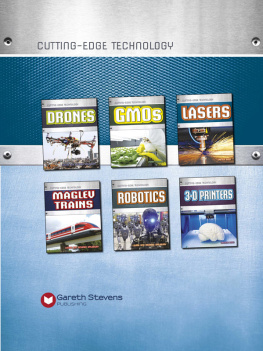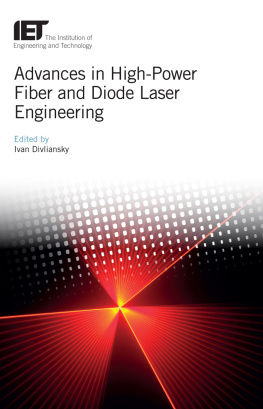Page List

Please visit our website, www.garethstevens.com.
For a free color catalog of all our high-quality books,
call toll free 1-800-542-2595 or fax 1-877-542-2596.
Cataloging-in-Publication Data
Names: Bow, James.
Title: Lasers / James Bow.
Description: New York : Gareth Stevens Publishing, 2017. | Series: Cutting-edge technology | Includes index.
Identifiers: ISBN 9781482451641 (pbk.) | ISBN 9781482451580 (library bound) | ISBN 9781482451467 (6 pack)
Subjects: LCSH: Lasers--Juvenile literature.
Classification: LCC TA1682.B69 2017 | DDC 621.366--dc23
First Edition
Published in 2017 by
Gareth Stevens Publishing
111 East 14th Street, Suite 349
New York, NY 10003
2017 Gareth Stevens Publishing
Produced for Gareth Stevens by Calcium
Editors: Sarah Eason and Harriet McGregor
Designer: Jessica Moon
Picture researcher: Harriet McGregor
Picture credits: Cover: Shutterstock: kadmy (photo), Shutterstock: Eky Studio (banner), Shutterstock: R-studio (back cover bkgrd); Insides: Creative Works, Inc. (www.thewoweffect.com) 25; NASA: NASAs Goddard Space Flight Center Scientific Visualization Studio 37; Shutterstock: Anyaivanova 21, Asharkyu 28, Bildagentur Zoonar GmbH 45, Alexander Gospodinov 5, Imfoto 13, Sanchai Khudpin 33, Lightpoet 27, Gardar Olafsson 34, Anita Ponne 7, Fouad A. Saad 9; Wikimedia Commons: 39, Creative Tools from Halmdstad, Sweden 41, Directed Energy Directorate/U.S. Air Force 31, ESO/Yuri Beletsky 42, Damien Jemison/LLNL 1, Krorc 19, LLNL 17t, NASA 17b, 23, Tatoute 11, U.S. Army Space & Missile Defense Command 14.
All rights reserved. No part of this book may be reproduced in any form
without permission from the publisher, except by reviewer.
Printed in the United States of America
CPSIA compliance information: Batch #CS16GS: For further information contact Gareth Stevens, New York, New York at 1-800-542-2595.
CONTENTS
O ver the last 100 years, technology has changed the world in ways that people could once hardly have imagined. However, all of our inventions, from the 3-D printer to maglev trains, started when somebody was inspired to imagine, investigate, and experiment. From these discoveries, technologies were invented that changed the way people lived. Lasers are one of the incredible cutting-edge technologies that have transformed our world.
WHAT IS A LASER?
Lasers are rays of light energy that people use in many different areas of their lives. The word laser means Light Amplification by Stimulated Emission of Radiation. Amplification means that the power of the light has been increased. Stimulated Emission of Radiation means that energy has been added to the radiation, making it more powerful. Grocery stores have lasers to read barcodes, the police use lasers to measure distance and speed, and lasers can even join atoms together. It is hard to believe that 100 years ago, lasers did not even exist!
In this book, we will look at how lasers work and how scientists invented them. We will show how lasers have changed the way we live and the incredible things lasers have made possible.
LASER BEAMS
Science fiction often shows laser beams shooting around and causing damage. However, it is not usually possible to see laser beams, until they hit something. Light travels in one direction, and it has to hit something, such as a wall or dust, to scatter and be reflected, or bounced, toward your eyes so you can see it. Laser beams can be seen in the same way.

Laser beams are concentrated beams of light. They focus a lot of light on a small space. This can create beautiful light shows or burn holes in things.
A BRIEF HISTORY OF LIGHT
T he journey to understanding lasers began with the study of light. Early scientists studied light by observing it. They could see light as a beam shining into a darkened room through an opening in a curtain. They could amplify, or make stronger, sunlight by shining it through a magnifying glass, producing a point of light so hot it could burn. They began to understand that light was something they could work with.
SPLITTING LIGHT
In 1666, Sir Isaac Newton (16421727) shone a beam of white light through a prism, which is a triangular-shaped wedge of glass. He split the light into the colors of the rainbow. He showed that light moves like waves and that the different colors of light are moving at different wavelengths. When light waves hit a prism, the glass changes the direction of the light. The different wavelengths bend in slightly different directions, and so all the colors separate.
LIGHT AS ENERGY
In 1845, Michael Faraday (17911867) was working with electricity and magnetism when he discovered that these forces could be used to change light. This was called the Faraday Effect. It suggested that light was a form of energy, like electromagnetism. Faradays friend, James Clerk Maxwell (18311879), proved this to be true 30 years later. Light is part of a larger spectrum, or range, of energy. The longer the wavelength, the lower the energy. Infrared light, microwaves, and radio waves have longer wavelengths than visible light. Ultraviolet light, x-rays, and gamma rays have shorter wavelengths than visible light. The shorter the wavelength, the higher the energy of the wave.

When a light beam bends when traveling from one substance to another it is called refraction. Here, white light refracts as it moves from air to glass. It splits into the colors of the rainbow.
ENERGY WAVES
Waves of energy are a series of peaks and dips, like waves moving along the surface of water. The space between two of the peaks is called a wavelength. When these peaks are close together, the wavelengths are shorter. They are said to have a higher frequency. When the peaks are farther apart, there is less energy, and the wavelengths are longer. They have a lower frequency.
THE POWER OF LIGHT
A lthough we have talked about wavelengths of light, Newton believed that light was a small piece of matter called a particle. Scientists have argued about the question of whether light is a wave or a particle for centuries.
WAVES OR PARTICLES
Light acts like a wave. It bends, like water does, when a wave hits a narrow opening in a wall. To see this in action, stand in front of a bright light and place your hands together, palms facing toward you, so they are between you and the light. Do you notice the dark lines in the gap between your hands? That is waves of light bending as they come through the gap, producing spots where there is no wave and no light. However, light also acts like a particle. It bounces off surfaces like a rubber ball and moves in straight lines.
PHOTONS

















